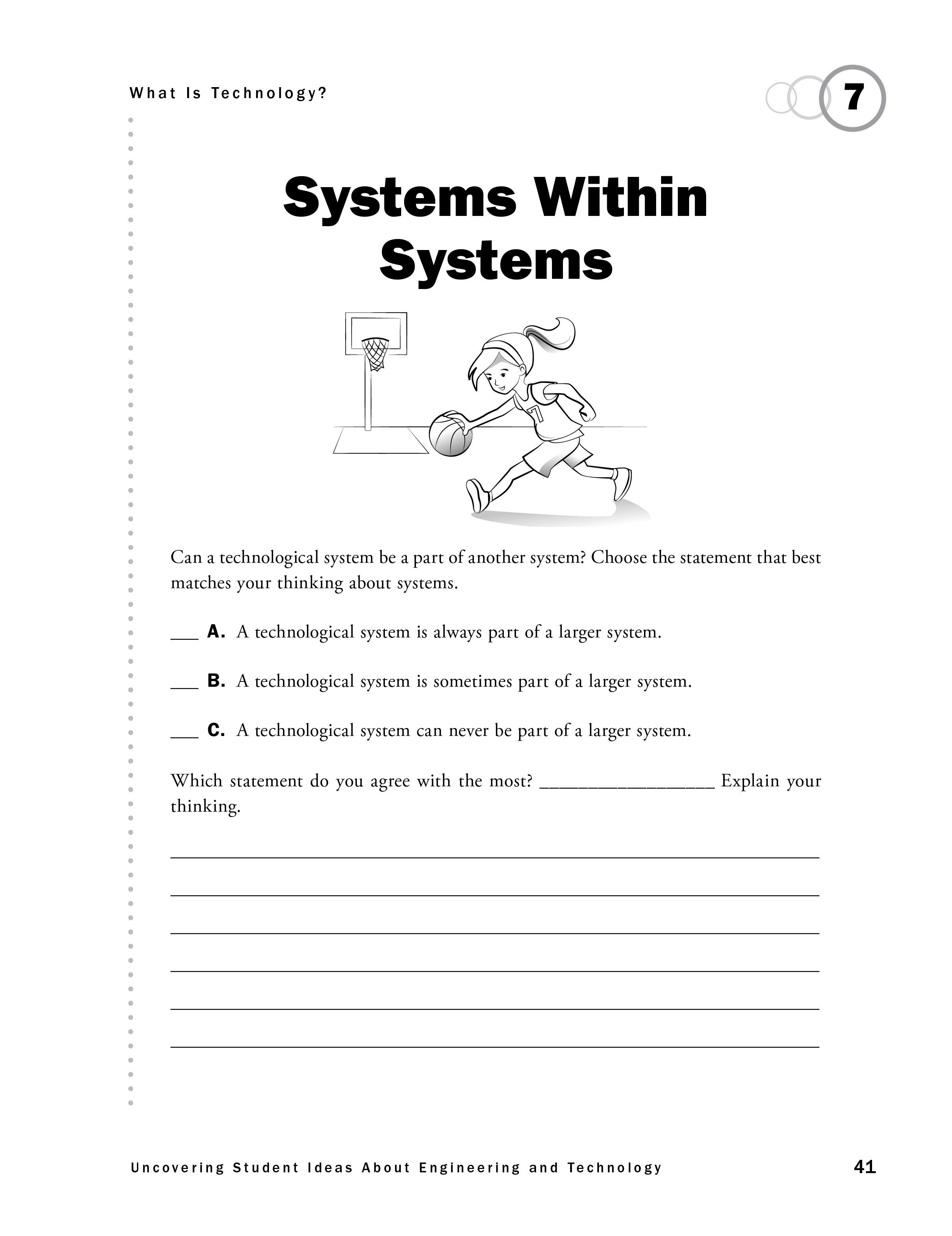Formative Assessment Probe
Systems Within Systems
By Page Keeley, Cary Snider, and Mihir Ravel
This is the 12th book in the Uncovering Student Ideas in Science series. Like the other books in this series, Uncovering Student Ideas in Engineering and Technology provides a collection of unique questions, called formative assessment probes, that are purposefully designed to reveal preconceptions students bring to their learning as well as to identify misunderstandings students develop during instruction that may go unnoticed by the teacher. Each probe is carefully researched to develop distracters that mirror commonly held ideas students have about the key ideas or practices. The probes are not grade-specific. They are designed to be used across multiple grade spans as well as with adults for professional learning or preservice education, especially since alternative ideas that go unchallenged often follow students from one grade to the next, right into adulthood.

Purpose
The purpose of this assessment probe is to elicit students’ ideas about technological systems. The probe is designed to determine the extent to which students recognize that all systems are nested within and interconnected with larger systems.
Type of Probe
Always, sometimes, never
Related Key Ideas
- Technologies consist of products, processes, and systems.
- A system is composed of two or more parts, and its function differs from that of the individual parts.
- Technological systems are nested within larger systems.
Explanation
The best answer is A: A technological system is always part of a larger system. For example, an athletic shoe worn by a basketball player has several different parts, each designed to give the wearer comfort and support. The shoe is just one part of a basketball player’s clothing, which in turn is part of a larger system that includes the ball and net, the court, and chairs or benches for the spectators. If it is a high school game, the basketball system includes uniforms and pom-poms used by cheerleaders, school buses that transport teams to different cities, and newspapers that report the results.
In practice, it is sometimes a useful simplification to define and think of a system as being by itself so that it can be analyzed or operated fairly independently of outside influences. For example, in a controlled scientific experiment, scientists often go to great lengths to isolate a system under study from external influences that might disturb it during the experiment. This is an example of a situation in which it is useful to think of a system by itself. In general, though, it is important in engineering to encourage students to consider how a system fits in with other systems, since a change in one system may cause changes in related systems.
Administering the Probe
This probe is best used with students in grades 6–12, after they learn that a system is made up of interacting parts. You can extend the probe by having students provide examples to support their answer choice.
Related Research
- Dalrymple, Sears, and Evangelou (2010) found significant pre-post assessment differences in first-year college students’ understanding of system interconnectivity and their abilities to redesign solutions after doing a scaffolded “dissection” activity in which they took a product apart to examine its subsystems.
- Silk and Schunn (2008) Identified engineering concepts of systems and optimization as foundational to the discipline of engineering education. They then reviewed existing literature and concluded that “a focus on the core engineering concepts of systems and optimization in K–12 engineering education has the potential to provide a solid foundation for continued study of engineering at the undergraduate level and beyond” (p. 1).
- Mehalik, Doppelt, and Schunn (2008) presented a unit in which students designed and built electrical alarm systems to 26 classes (585 students) of eighth graders, and compared the results with 20 classes (466 students) of eighth graders who learned the same material through a scripted approach. In the scripted approach, the students do the activity with the same materials, but their work is heavily scaffolded to help them discover scientific concepts rather than encourage them to design the system. The students were assessed on science content that was included in both teaching methods. The students engaged in designing systems had a higher achievement in core science concepts, engagement, and retention than the students who learned through the scripted approach. The systems design approach was most helpful to low-achieving African American students.
Suggestions for Instruction and Assessment
- Starting with a brick, have students fill in the blanks in the following sentence (possible answers are in parentheses): A brick is part of a __________ (wall), which is part of a __________ (building), which is part of a __________ (city). Then challenge them to select a simple technological object and list how many systems within systems they can come up with. For example: A handle is part of a faucet, which is part of a sink, which is part of the kitchen, which is part of a house, which is part of a neighborhood, which is part of a city.
- Ask the students to name the major systems in a car, such as the body, engine, and tires. Then choose one of the systems and ask them to name some of its subsystems, then the parts that make up those subsystems, and so on.
- Compare technological systems with natural systems to see how both are made up of systems within systems. For example, a cell is part of a system of tissues, which are part of an organ, which is part of an organ system, which is part of an organism, which is part of a population of organisms, which is part of an ecosystem.
- Starting with the basketball player’s shoe, describe the shoe as a system with interacting parts. Then describe the shoe as one part of a basketball player’s clothing, and so on. See how far the students can get at nesting systems within systems.






